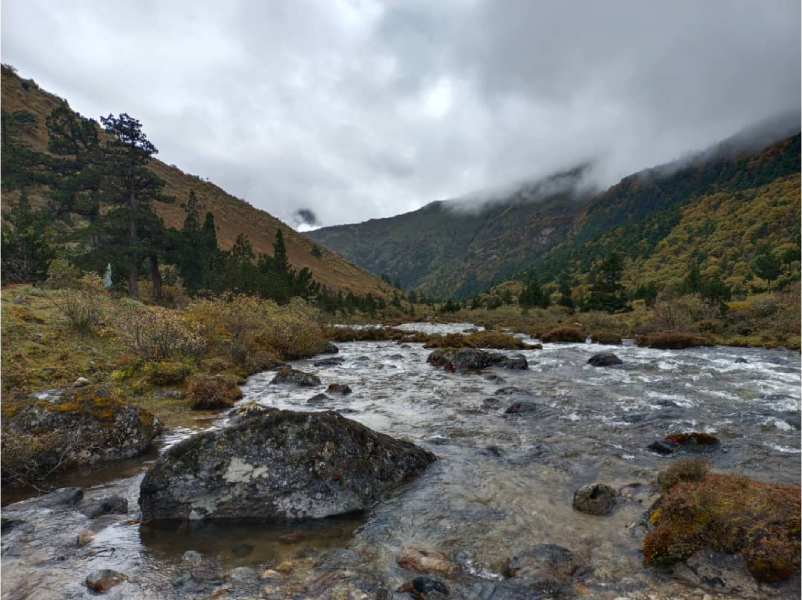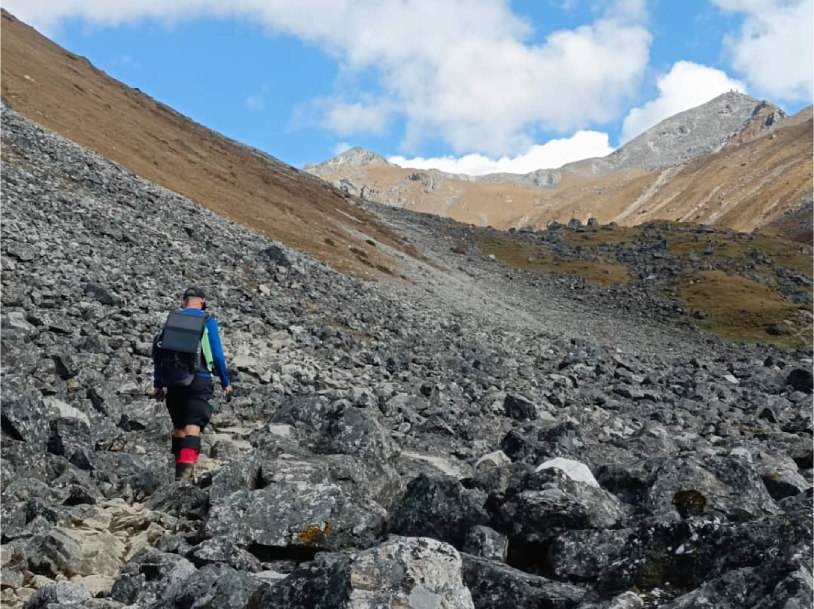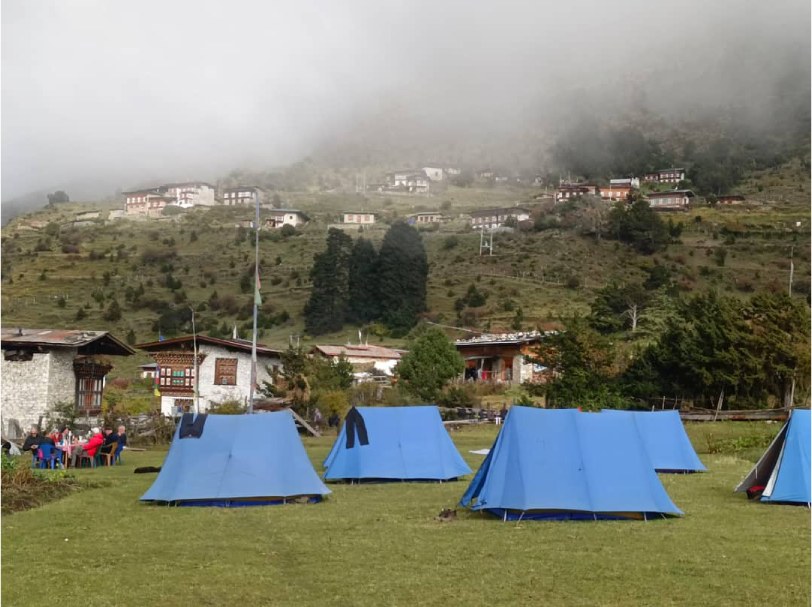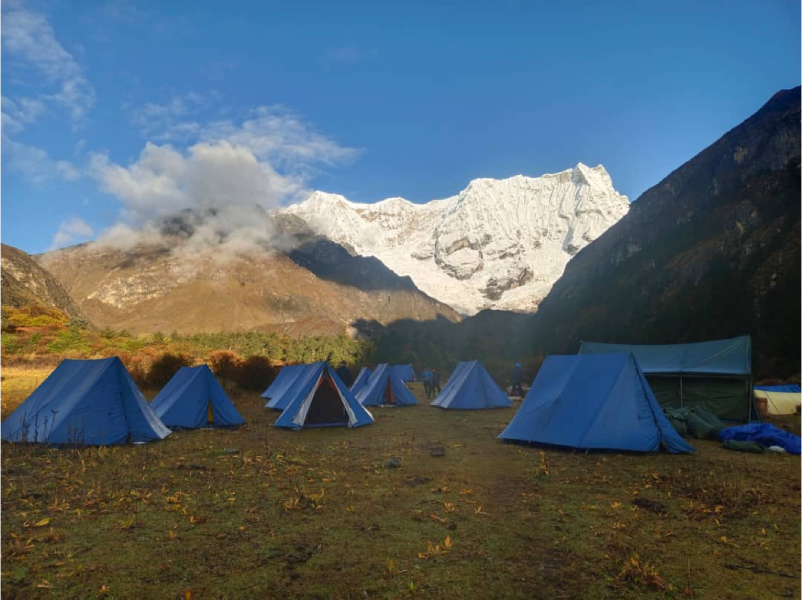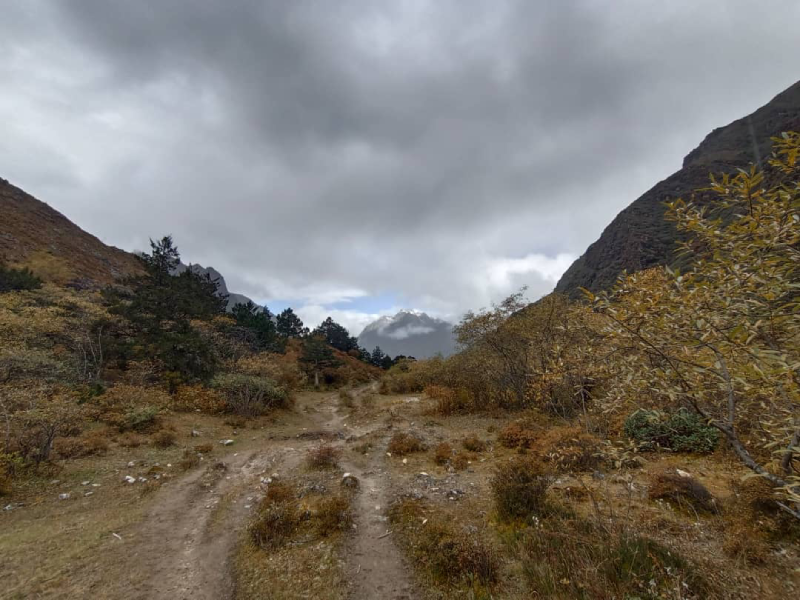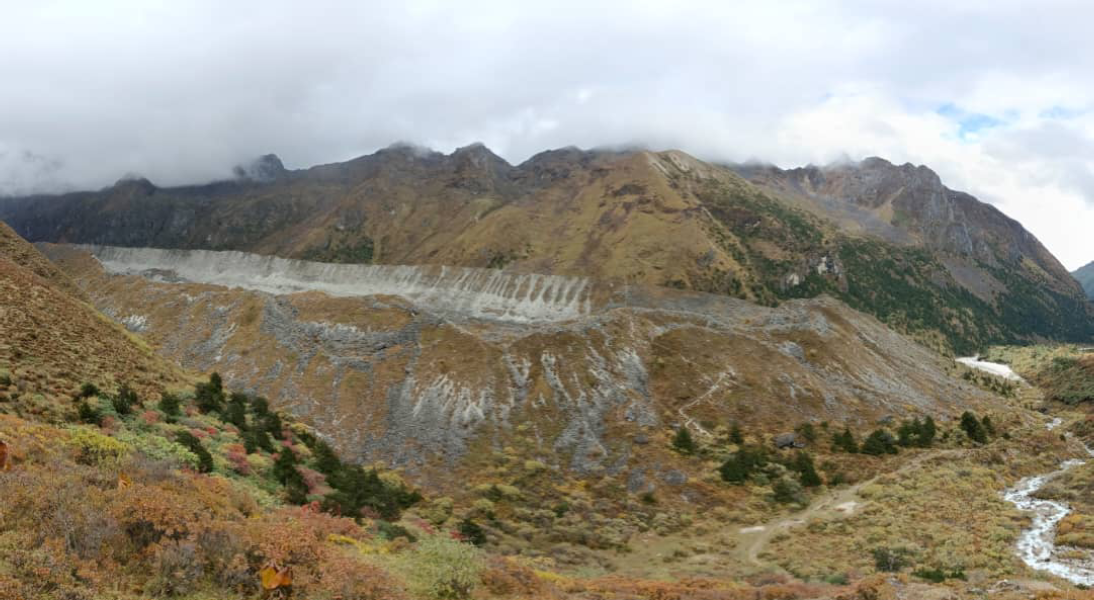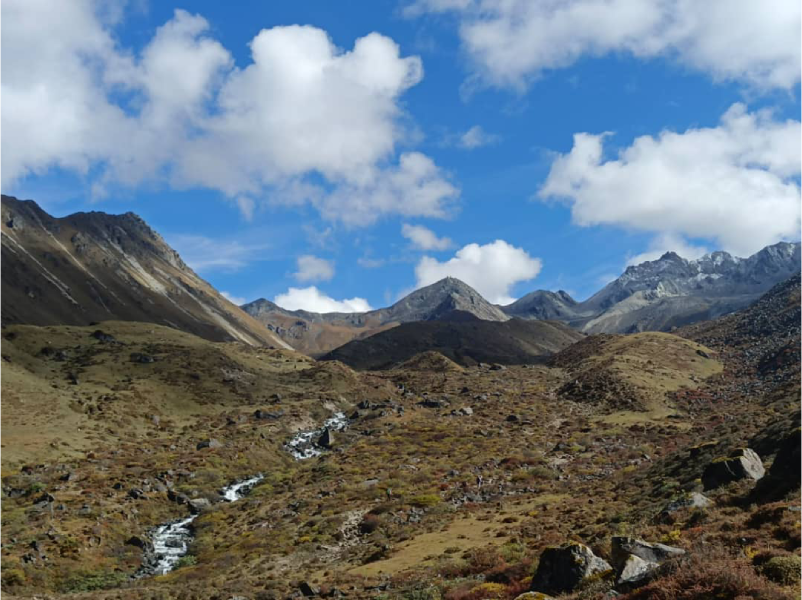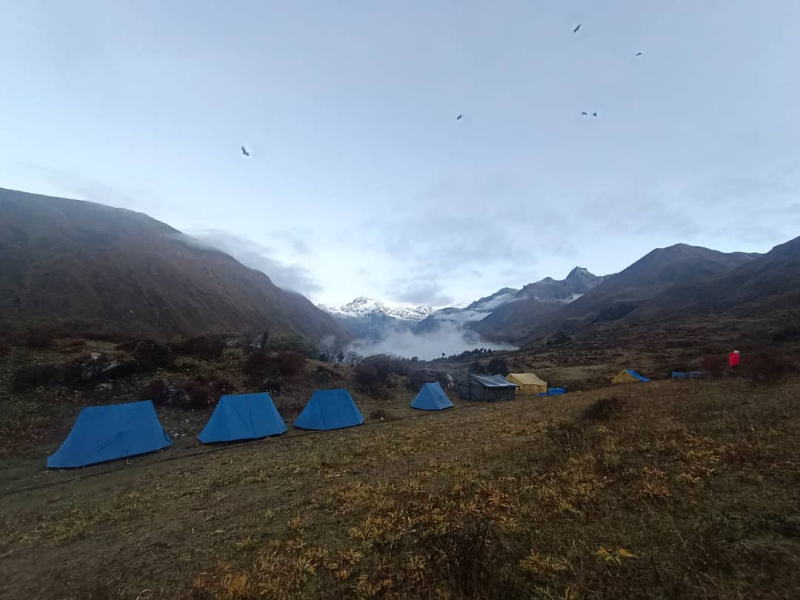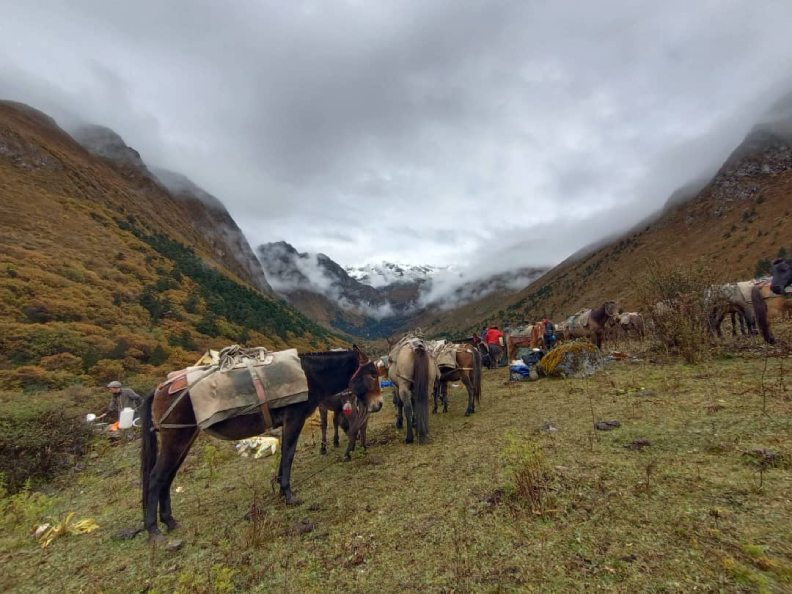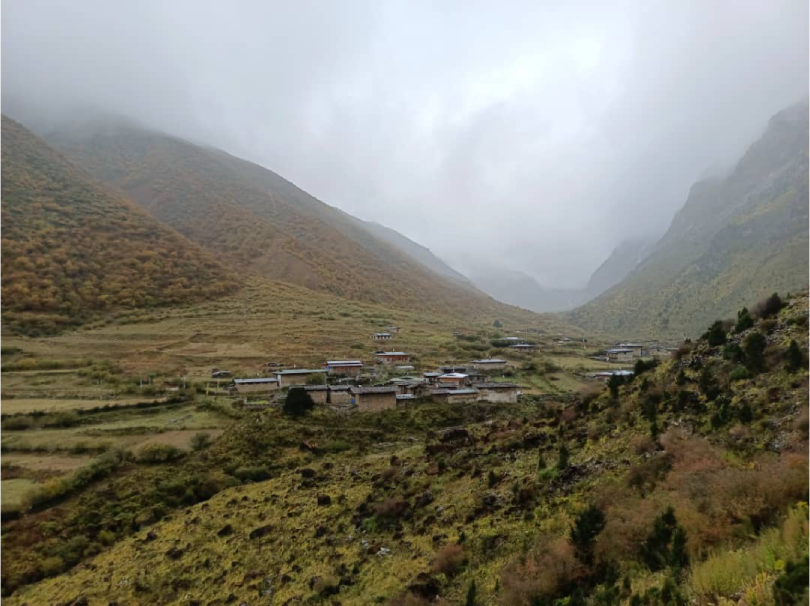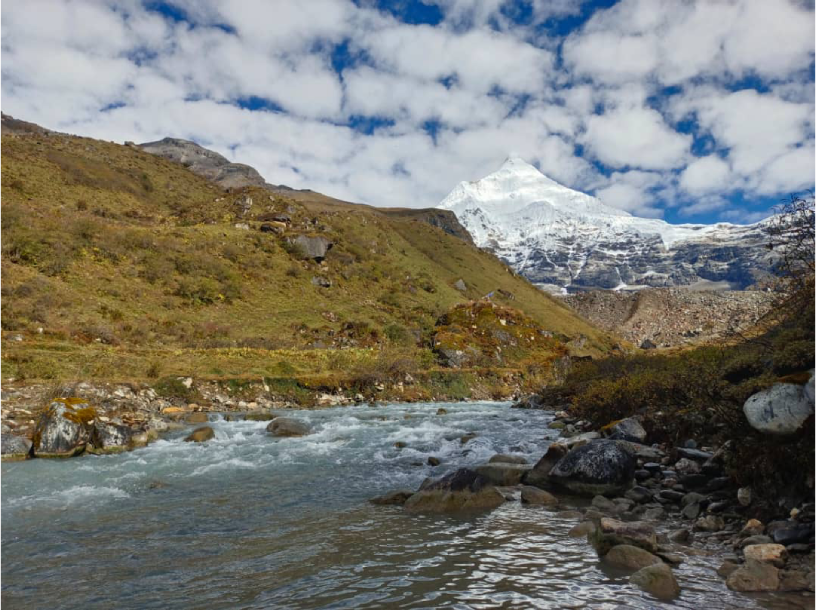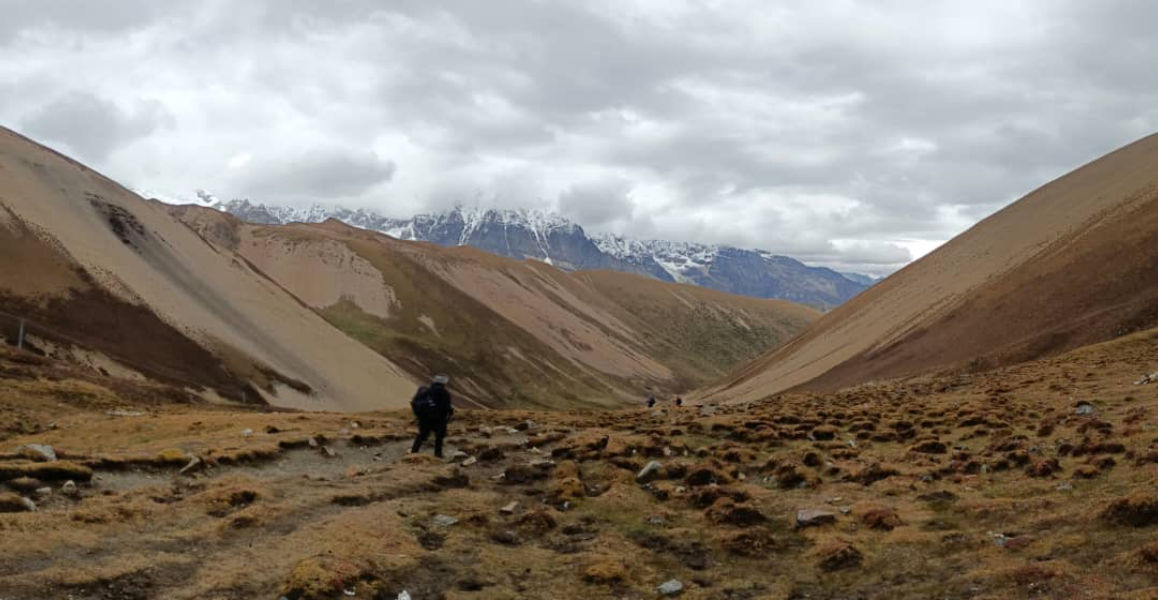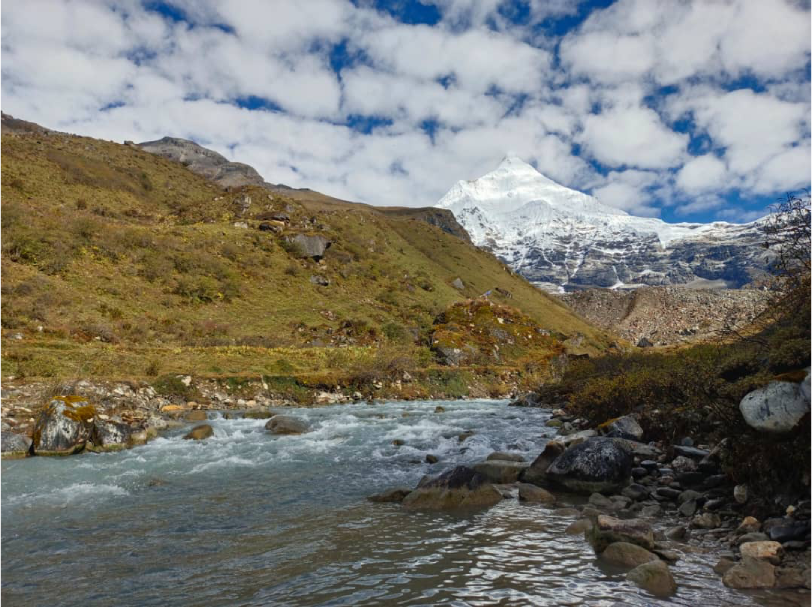Laya Gasa Trek 14 Night 15 Days
Laya Gasa Trek 14 Night 15 Days
The Laya Gasa Trek in Bhutan unfolds a mesmerizing adventure through pristine landscapes and cultural gems. Spanning around 21 days, this trek ventures into the remote Laya region, renowned for its distinct culture and the fascinating Laya people. Traversing lush forests, high mountain passes, and traditional villages, the journey offers stunning views of Himalayan peaks, including Jumolhari and Gangchen Ta. Encounters with nomadic yak herders and visits to ancient monasteries enrich the cultural experience. The trek culminates in Gasa, known for its hot springs. The Laya Gasa Trek seamlessly blends natural beauty and cultural immersion, making it an unforgettable Himalayan odyssey.
Short Itinerary
| Title | Accommodation | Meals |
| Day 01: Arrival in Paro | Hotel | -/L/D |
| Day 02: Paro to Sharna Zampa | Simple Guest House | B/L/D |
| Day 03: Sharna Zampa to Soi Thangkha | Simple Guest House | B/L/D |
| Day 04: Soi Thangkha to Jangothang base camp | Simple Guest House | B/L/D |
| Day 05: Jangothang acclimatization and exploration | Simple Guest House | B/L/D |
| Day 06: Jangothang to Lingshi | Simple Guest House | B/L/D |
| Day 07: Lingshi to Chebisa | Simple Guest House | B/L/D |
| Day 08: Chebisa to Shoumothang | Simple Guest House | B/L/D |
| Day 09: Shoumothang to Robluthang | Simple Guest House | B/L/D |
| Day 10: Robluthang to Lingmithang | Simple Guest House | B/L/D |
| Day 11: Lingmithang to Laya | Simple Guest House | B/L/D |
| Day 12: Rest day at Laya | Simple Guest House | B/L/D |
| Day 13: Laya to Koena to Gasa | Simple Guest House | B/L/D |
| Day 14: Gasa to Paro | Hotel | B/L/D |
| Day 15: Final Departure | B |
Tour Program
Expand AllUpon your arrival at Paro Airport, you will be warmly welcomed by our representative from Journey DMC who will assist you with the necessary arrival formalities. Paro is the gateway to Bhutan and offers a picturesque introduction to the country with its stunning landscapes and serene atmosphere.
After completing the arrival formalities, you will be transferred to your hotel in Paro. Take this time to relax and unwind from your journey and get settled into your accommodation. Paro is a charming town located in a beautiful valley and is known for its rich history, culture, and natural beauty. You can explore the town in the evening, maybe take a stroll, and enjoy the local cuisine at one of the restaurants in the area.
Hotel
-/L/D
The trek commences from the historic Drugyel Dzong (2580m), a 12km drive north of Paro Valley. Here, you meet your trekking crew, embarking on a journey through breathtaking landscapes. The trail begins on a wide path alongside the Pa Chhu (Paro River), gradually ascending through the countryside, offering views of rice paddies and millet fields. The valley widens to reveal apple orchards, traditional farmhouses, and settlements like Mitshi Zampa and Sangatan. Passing through the blue pine forest, you'll reach the army post of Gunitsawa at 2810m, where trekking permits are checked. Crossing the Pa Chhu on a wooden bridge, the climb continues to Sharna Zampa (2870m), a serene campsite nestled in meadows among the trees for a night's rest.
Simple Guest House
B/L/D
Similar to the previous day, the trail follows the course of the Pachhu (Paro River), navigating ascents and descents through pine, oak, and spruce forests. After approximately 2 hours of hiking and crossing several streams, you'll arrive at Shingkharap, a stone house situated at 3110m. Crossing the bridge to the left side of the river, a hot lunch is served. Continuing, a trail junction presents itself, with the left road representing an old trade route to Tibet and the right leading to a wooden bridge. Opting for the latter route, the journey involves climbing through rhododendron forests and, after crossing the bridge again, reaching the camp at 3750m, situated amidst beautiful meadows.
Simple Guest House
B/L/D
On this day, although the trekking distance is not extensive, there's a significant gain in altitude as the trail ascends above the tree line. Starting from the camp, the path leads to an army camp, and from there, it follows the river above the tree line, offering spectacular views of the surrounding mountain peaks. After traversing a muddy section and passing a mani wall, the trail enters Yak Country. A hot and filling lunch awaits inside a yak herder’s camp. Post-lunch, the trek continues past yak herder settlements of Soe and Takethang, where locals cultivate crops like barley, potatoes, and turnips. Crossing a plateau and ascending a stream bed, the journey passes Dangochang village and reaches the beautiful campsite of Jangothang at an altitude of 4040m. The panoramic views of Mount Jumolhari and Jichu Drake from here are awe-inspiring.
Simple Guest House
B/L/D
On this day, a four-hour acclimatization hike awaits you to the north of your camp. Though there isn't a defined trail, you'll climb an open and endless slope until you're greeted with the view of Mt Jichu Drake (6989m). For the more adventurous, a hike further up to 4895m (higher than Mount Blanc) offers an amazing perspective of Mount Jumolhari. Keep an eye out for rare blue sheep, Himalayan rhubarb, griffon vultures, golden eagles, and the national flower – the blue poppy. The Jangothang base, set against the colossal Mount Jumolhari and Jichu Drake, provides a flat grassy land with the ruins of an old fortress on a hillock. Given the altitude, it's highly recommended that all trekkers halt here, as signs of mountain sickness often appear. The day offers the option to hike or simply rest in camp, ensuring a truly memorable experience.
Simple Guest House
B/L/D
The trail for today follows the stream for half an hour before crossing the bridge to the right side. As you begin to climb up to the first ridge, a breathtaking view unfolds of Jumolhari (7314m), Jichu Drake (6989m), and Tsherim Gang (6789m). Walking on an almost flat track for a while towards the valley, the path then ascends to the Ngye La pass at 4700m. After crossing the pass, a gradual descent leads to the campsite, providing a spectacular panoramic view of the peaks and Lingshi Dzong. If time allows, a detour to the tiny fortress, Lingzhi Dzong, perched on a hilltop overlooking Lingzhi village is recommended. Historically, Lingzhi Dzong served as a way station for weary Buddhist pilgrims and a defence fort against Tibetan and Mongol invaders. The campsite for the day is at an altitude of 4010m.
Simple Guest House
B/L/D
Nestled on a hilltop with panoramic views of verdant hills, winding rivers, and majestic peaks, Lingshi Dzong stands as a testament to centuries of history. Once a crucial way station for Buddhist pilgrims and a formidable defence fort against Tibetan and Mongol invaders, Lingshi Dzong offers a glimpse into the region's rich past. Today's trek is relatively easy, featuring pleasant walks through villages and yak herders' camps. After lunch, a short stroll brings you to Chebisa, a charming village adorned with a pristine crystal-clear waterfall. The day concludes with camping by the side of a stream at an altitude of 3850m, providing a serene setting for the night.
Simple Guest House
B/L/D
The trek for today kicks off with a challenging climb up a ridge to the Gogu La pass (4500m), a four-hour endeavour. This ascent provides a chance to spot rare blue sheep often seen on the rocks near the top of the pass. Following the pass, the route descends, passing through rhododendron bushes to a lunch stop. In the afternoon, the journey continues with scattered ascents and descents, crossing streams, traversing rhododendron forests, and passing by yak herders' camps. The trail leads to Shakepasa at 3980m, and from this point, a steep ascent on the northern side of the valley takes you past yak herder’s camps. The day concludes at a campsite beside a stream, situated at an altitude of 4250m.
Simple Guest House
B/L/D
The trek for today commences with a walk through the Edelweiss-bound trail, followed by a climb to Jari La passes at an altitude of 4700m. To the southeast, the snow-capped peak Kangbum at 6526m comes into view. The descent leads to Tsarijathang Valley, the summer residence of rare Himalayan Takins, the national animal of Bhutan. Crossing streams without footbridges may be necessary, as these bridges are often washed away. Following the stream crossing, the trail ascends to the left, eventually reaching Robluthang, a rocky meadow camp at an altitude of 4200m. The day's journey unfolds amidst breathtaking mountain landscapes and unique wildlife encounters.
Simple Guest House
B/L/D
Today promises to be an exhilarating adventure as you conquer the highest pass in the entire trek. The journey involves a continuous climb through boggy patches, crossing streams, and encountering marmot holes and moraine. The ascent leads to the apex of Shingchen La Pass at an impressive altitude of 5005m. At the summit, you'll be greeted by the breathtaking sight of the snow-covered Gangchenta, also known as the Tiger Mountain (6840m), dominating the northern horizon. After soaking in this awe-inspiring view, the descent follows a rough and rocky trail along the Moraine River valley to the Kango Chhu River. Expect narrow paths and the possibility of crossing streams, getting a bit wet in the process. A refreshing walk through cedar forests eventually brings you to Lingmithang (4140m), a beautiful campsite featuring scattered meadows by the river, with the majestic Tiger Mountain (Gangchenta) towering in the backdrop.
Simple Guest House
B/L/D
In the morning, you'll wake up to a superb view of Gangchenta Peak. The trek to Laya unfolds with pleasant walks and breathtaking views. Passing through a damp forest adorned with moss and the melodies of singing birds, the journey spans a relatively long distance through this uninhabited valley. Along the way, a waterfall graces the trail, adding to the scenic beauty. As you progress, you'll reach a junction, and opting for the upper route leads to fields dotted with stone houses. The final destination for the day is Laya village, situated at an altitude of 3800m. Laya stands as the second-highest settlement in the country, offering a unique blend of natural beauty and cultural richness.
Simple Guest House
B/L/D
Today offers a day to tailor to your preferences. Explore Laya village, interacting with the locals and visiting any of the houses that welcome you. Bhutanese hospitality is a significant aspect of the culture, and even strangers are often offered a cup of tea and Chang (local wine). The people of this valley are known for their interesting lifestyle and attire. Women, in particular, don conspicuous attire, including conical bamboo hats adorned with turquoise and silver ornaments. Immerse yourself in the rich traditions, customs, and warm hospitality of Laya, taking in the unique charm of this high-altitude settlement.
Simple Guest House
B/L/D
The descent from Laya begins, leading you to the army camp where you'll join the Mo Chhu, the Mother River of Punakha. Following the river, you'll cross a bridge and then encounter several ascents and descents through juniper and fir forests until you reach Koena at an altitude of 3800m. At Koena, you'll be met by your car and driver, who will transfer you to Gasa village. The drive takes you through fir, spruce, and rhododendron forests, descending approximately 1250m to reach Gasa. Here, a relaxing dip in the Tshachu or hot spring awaits, providing a soothing remedy for any muscle aches after the long trek.
Simple Guest House
B/L/D
The drive from Gasa to Paro involves a scenic journey through the beautiful landscapes of Bhutan. As you travel, you'll likely pass through diverse terrain, including forests, valleys, and perhaps some charming villages. The exact route may vary, and the drive will provide an opportunity to enjoy the natural beauty of Bhutan. Upon reaching Paro, you can explore the town and relax after your trekking adventure.
Hotel
B/L/D
The last day morning will be free and near the time of your flight. You will be at the airport within the time to board your flight for the onward trip.
B
Tour Includes
- Arrival and departure transfer.
- All necessary surface transfer by private vehicles.
- 3 Nights hotel accommodation in a twin-sharing room on a Full board basis during the trip.
- 11 Nights Simple Lodge accommodation in a twin-sharing room on a Full board basis during the trip.
- All the sightseeing tours and transfers as per the itinerary with English speaking guide by private vehicle.
- Bhutan E-Permit
- Sustainable Development Fund (SDF)
- Bhutan Visa Fee
- Entrance Fee
- All the trekking Equipment
- Horses to carry trekking equipment
Tour Excludes
-
International Airfare (Quoted separately - subject to change if revised)
-
International airport taxes
-
Entrance fee in Bhutan (Directly payable at location)
-
Items of a personal nature such as bar bills, alcoholic beverages, laundry, telephone calls, extra mileage, personal gratuities such as tips to guide, porters, drivers, etc.
-
Personal insurance policy - suggested comprehensive travel insurance covering tour and flight cancellations, loss of valuables, thefts, illness, accidents, and hospitalization
-
Excess baggage
-
Expenses incurred by re-routing, inclement weather, floods, famine, political disruptions, strikes, riots, and other disturbances
-
Any items and services not mentioned on cost inclusions.
-
Any meals that are not mentioned on cost inclusions.
-
Sleeping bag.
FAQ
Expand AllThe best time for this trek is during the spring (March to May) and autumn (September to November) when the weather is stable, and the views of the mountains are clear.
The highest point on this trek is Shingchen La Pass at 5005m. Proper acclimatization days are included in the itinerary to help prevent altitude sickness.
Accommodation during the trek is in simple lodges, which offer basic facilities. In Paro and Gasa, you will stay in hotels with better amenities.
While prior trekking experience is not mandatory, a good level of physical fitness is required as the trek involves long days of hiking, steep ascents, and high altitudes.
Trekking permits are checked at multiple points, such as Gunitsawa.
Altitude sickness can be a concern as the trek reaches over 5000m. An acclimatization day is planned at Jangothang, and the itinerary allows for gradual altitude gain to reduce risks.
Key highlights include stunning views of Mount Jumolhari, Jichu Drake, and Tiger Mountain, visits to traditional Bhutanese villages, encounters with yak herders, and the unique cultural experience of Laya.
Yes, you will visit Bhutanese villages like Laya, where you can interact with locals, learn about their traditions, and experience their hospitality.
A detailed packing list will be provided, but essentials include warm clothing, trekking boots, a sleeping bag, a rain jacket, and personal medication.
Things to know
1. One of Bhutan’s Most Challenging Treks
- The Laya–Gasa Trek is a demanding 13 to 15-day trek that begins at Drukgyel Dzong (Paro) and ends in Gasa, traversing high passes and remote wilderness.
- It includes multiple days above 4,000 meters, with two major high passes:
- Nyile La (4,870m)
- Shinge La (5,000m)
2. Spectacular Mountain Scenery
- The trek offers up-close views of Mount Jomolhari, Jichu Drakye, and Tshering Gang.
- You'll cross glacial rivers, hike through alpine meadows, and camp in high valleys with panoramic vistas.
3. Cultural Encounters with Layap People
- The highlight is visiting Laya village (3,850m), home to the Layap people, a semi-nomadic community with their own distinct language, dress, and customs.
- Interaction with locals offers rare insight into Bhutan’s highland life and preserved traditions.
4. Ending in Gasa with Natural Hot Springs
- After days of strenuous trekking, the trail ends in Gasa, where you can relax in the natural hot springs, famed for their healing properties.
- Gasa also features a historic dzong (fortress) perched above a river gorge.
5. Best Season and Trekking Support
- The best seasons are April–May and mid-September–October for clear weather and mountain views.
- It’s a fully supported camping trek, requiring good physical fitness, proper gear, and acclimatization.
Why Book With Us?
- Expert Knowledge
- Customized Itineraries
- Immersive Experiences
- Seamless Travel
- Safety and Comfort
- Cultural Sensitivity
- Flexible Options
- Best Tour Guides
- Unmatched Hospitality
- Personalized Support
- Sustainable Tourism
- Local Partnerships
